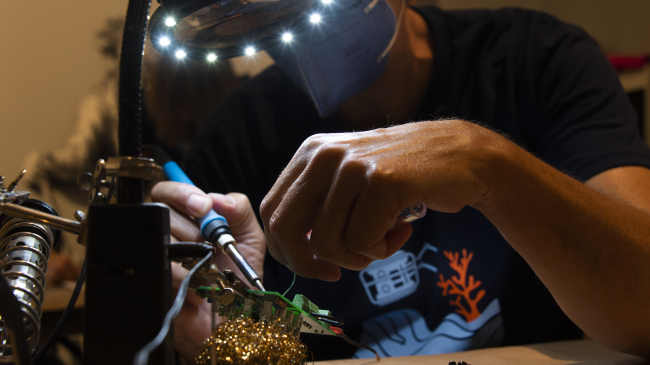Every community faces its own set of environmental hazards. For Easton, Pennsylvania, the big issue is flooding. From 2004 to 2006, repeated flooding events along the Delaware River prompted the Nurture Nature Foundation to create the Nurture Nature Center offsite link with the goal of educating the local community about the risks of flooding. Since then, the Nurture Nature Center has expanded to educate the general public across a range of environmental topics, in Easton and beyond.

This illustration depicts community membeers gathering measurements and collaborating to understand their ecosystems. (Image credit: NOAA Office of Education & Jessica B. Bartram, licensed under CC BY-NC-SA 4.0)
While their scope has grown, the theme of local environmental resilience has carried through to today. In fact, it was part of the motivation for collaborating with NOAA’s Office of Education, through its Environmental Literacy Program, to create the Climate Resilience in Your Community Activity Book that gives young people tools to advance community resilience, no matter where they live.
The book was created as part of the Community Resilience through Education, Art, Technology and Engagement (CREATE) Resilience project. This is a multi-disciplinary collaboration led by Nurture Nature Center with a grant provided by ELP. The book includes six main sections focused on education and resiliency vocabulary, community resources, traditional ecological knowledge, community preparedness, environmental justice, and taking action. Learners complete a variety of activities, such as a crossword, an iSpy activity, local community research, a news story writing exercise, and an action plan development activity. Through these tasks, the book introduces young learners to a variety of topics, from climate change and resiliency to citizen science and environmental justice. By going through the activity book, young people discover ways that they can make a difference, earning badges as they accomplish the different activities.
The activity book was designed for learners in grades 3-8 for use in formal and informal educational settings. Each of the six sections of the book mirrors key concepts from the NOAA’s Community Resilience Education Theory of Change that outlines how and why K-12 formal and informal education programs are critical to building community resilience. “The theory of change is a long, technical report written for educators and other adult professionals whose work focuses on building community resilience to climate change impacts. This activity book allows us to expose younger audiences and their families to these critical concepts in a fun way,” said Sarah Schoedinger, Senior Education Program Manager for ELP. The activity book also includes an educators’ guide with tips for adjusting each activity for different grade levels and provides alignment of the activities with Next Generation Science Standards.
The Nurture Nature Center is dedicated to engaging youth and adults in learning about environmental risks and building community resiliency by leveraging the power of informal science education, engagement in the arts, and community dialogue and networking. The grant, in addition to the activity book, produced murals that represent community resilience offsite link, created a video for NOAA’s Science On a Sphere offsite linkⓇ, established a group of youth resilience ambassadors, and created Nurture Nature Center’s Community Resilience Guidebook offsite link. Like the activity book, these products integrate art, science, and resilience education into collaborative community learning opportunities.
Although only recently available for distribution, the reach and impact of the activity book has been great. In the past few months, it has been distributed for Earth Science Week offsite link (9,000 copies), the 27th Conference of the Parties to the United Nations Framework on Climate Change, or COP27 offsite link (150 copies), the National Adaptation Forum offsite link, and multiple ELP grantees and their partners (about 3,000 copies). Additionally, the link to access the electronic version of the book has been sent through email and posted in NOAA’s social media. It has been downloaded more than 1,900 times.
ELP grantees have reported on the book’s positive impact. For example, Hannah Barg, Youth Climate Program Manager at The Wild Center offsite link, said, “This workbook clearly connects the dots between climate justice and climate resilience and how both are important to our local understanding and experience of climate change. I am excited to use this and other supplemental materials with rural teens in upstate New York.”
NOAA’s Environmental Literacy Program will continue to distribute and promote this new resource to help children and youth learn about and be engaged in local climate resilience.




